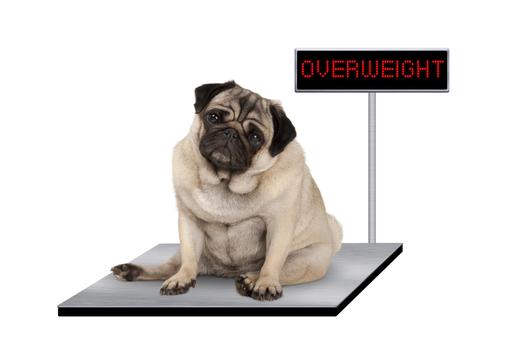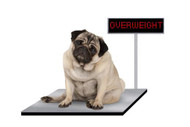Obesity in Pets: Not Just a Human Problem
2021 Jun 15th

Obesity is an ongoing issue in pets. Between 50-60% of cats and dogs are overweight according to reports by the FDA. Obesity can lead to several health problems including Diabetes, cancer, heart problems, breathing problems, and the list goes on and on. If your pet is overweight and you want to get a few pounds (or several, for that matter) off them, feeding them something that is lean is helpful, but getting them lots of exercise is the key! Unlike most people, dogs usually love to run and play. Giving them more of this daily exercise can drastically increase their ability to burn fat.
Let’s ask the important question first… IS YOUR PET OVERWEIGHT??
Below is a body conditioning score. However, different breeds have different body shapes so consider those factors before deciding if your dog is over or under weight.

Many breeds are more prone to obesity, such as labs and pugs. A good way to tell if your dog is a good weight is if you run your hand over your pet’s ribs, there should be a thin layer of fat covering them but the ribs should still be felt easily. This applied to dogs and cats.
Oh no, my pet is overweight… What should I do??
There are a few things that can be done:
- Feed a lean food with high fibre
- Give a fibre supplement
- Limit treats (Amount and Type)
- Get them LOTS of Exercise!
1. Feed a lean food with high fibre
Lean does not mean a low calorie food! Feeding guides and AAFCO guidelines are based on calories. This means there has to be a certain amount of nutrients in 1000 calories of food. Therefore, if a food is low in calories, that means the feeding guide will direct you to feed more. If you do not feed this amount you may not be supplying your pet with enough amino acids, vitamins and minerals. This will lead to a deficiency and resulting health problems. For this reason it is good to feed a food high in protein and low in fat. Good protein sources to look for this ratio are Turkey and Cod since they are a very lean meats. If you buy a food that says to feed your dog 4 cups and you feed them 2 cups to cut down on calories, you are also cutting out a lot of vital nutrients. Find a food with a lower feeding guide! The less you feed the denser the food (more nutrients per cup). What you will also want to look for is a food with a high fibre content (at least 5%). Fibre increases satiety and makes them feel full for longer by slowing down digestion. This will encourage them to eat less since the fibre bulks food in the gut.
A very important factor that people forget is you should be feeding your pet according to the weight you WANT them to weigh (how much they should weigh at a good weight for their size), NOT what they do weigh!
Let’s look at an example of two weight loss foods…
Hill’s Prescription Diet Weight Reduction Dog food
| 5 ½ Cups per day (450g) | |
| Whole Grain Corn, Corn Gluten Meal, Chicken By-Product Meal, Powdered Cellulose, Soybean Meal, Soybean Mill Run, Chicken Liver Flavor, Dried Beet Pulp, Pork Liver Flavor, Soybean Oil, Lactic Acid, Caramel color, Pork Fat, DL-Methionine, L-Lysine, Potassium Chloride, Choline Chloride, Iodized Salt, vitamins (Vitamin E Supplement, L-Ascorbyl-2-Polyphosphate (source of Vitamin C), Niacin Supplement, Thiamine Mononitrate, Vitamin A Supplement, Calcium Pantothenate, Vitamin B12 Supplement, Pyridoxine Hydrochloride, Riboflavin Supplement, Biotin, Folic Acid, Vitamin D3 Supplement), Calcium Carbonate, minerals (Manganese Sulfate, Ferrous Sulfate, Zinc Oxide, Copper Sulfate, Calcium Iodate, Sodium Selenite), Taurine, L-Carnitine, Mixed Tocopherols for freshness, Natural Flavors , Beta-Carotene |
Nutram Ideal Weight Control
| 2 Cups per day (210g) | |
| Chicken Meal, Deboned Chicken, Peas, Oatmeal, Brown Rice, Lentils, Pearled Barley, Whole Eggs, Pea Fiber, Dried Beet Pulp, Natural Chicken Flavor, Chicken Fat (preserved with Mixed Tocopherols), Dehydrated Alfalfa Meal, Flaxseed, Apples, Carrots, Salmon Oil, Pumpkin, Dried Whey Protein Concentrate, Choline Chloride, Potassium Chloride, Salt, Pomegranate, Cranberries, Chicory Root Extract, DL-Methionine, Vitamins & Minerals (Vitamin E Supplement, Vitamin A Supplement, Vitamin D3 Supplement, Niacin (source of Vitamin B3), d-Calcium Pantothenate (source of Vitamin B5), Thiamine Mononitrate (source of Vitamin B1), Riboflavin (source of Vitamin B2), Beta-Carotene, Pyridoxine Hydrochloride (source of Vitamin B6), Folic Acid, Biotin, Vitamin B12 Supplement, Zinc Proteinate, Ferrous Sulfate, Iron Proteinate, Zinc Oxide, Copper Proteinate, Copper Sulfate, Manganese Proteinate, Manganous Oxide, Calcium Iodate, Selenium Yeast), Glucosamine Hydrochloride, New Zealand Green Mussel, L-Carnitine, Dried Rosemary |
As you can see from the tables above, even though Hill’s has less calories per cup, because of the feeding guide, a 60lbs dog would end up consuming almost twice as many calories as if on the Nutram. The dog would also eat only 2/3 as much fat on the Nutram despite it being a higher percentage. Therefore, even though the Nutram food is Chicken-based it reads as a much more effective weight loss food. The only thing that indicates the Hill’s food would be good is the high fibre content. It is important to take note of these things when looking for a good weight loss food.
2. Give a Fibre Supplement
For this same reason mentioned above, giving a fbre supplement with their food will increase their feeling of fullness even more. This is especially important if you can’t find a food especially high in fibre. Good fibre sources include pumpkin, psyllium, and squash. Most dogs like pumpkin, but for picky eaters powdered products may be easier to hide in their food. Our Earth MD Weight Control and Digestive Care supplements are high in fibre and can help with this.
3. Limit Treats (Amount and Type)
Too many people complain that their dog is overweight, and they are dieting them, and then hand them a handful of treats. For obvious reason this is very counterproductive. Many treats are high in calories, full of sugars and fats. If you have a pet that needs to lose some weight, keep the number of treats limited, give small pieces, and feed a lean, high protein treat. The best treat is literally meat! Freeze-dried, dehydrated, raw… any of these are great options. Try and find a lean meat such as turkey or cod to limit the fat they are consuming.
4. Get them LOTS of Exercise!
Exercise is key! Dieting can only do so much. Just ask any person that has tried to lose weight through diet alone. It can be tricky with lazy cats or if you are not home to exercise your pet often, but honestly it is the only sure way to get them to lose weight in a healthy way. Find a favourite toy they like to chase, play fetch, have doggy play-dates, daycare where they can run around, anything to get them moving. My cats enjoy chasing their food like they are hunting it, so sometimes I throw individual pieces to get them moving (a great trick for cats only motivated by food or treats). There are supplements you can give your pets to increase their metabolism to help them lose weight. By increasing their metabolism they burn calories at a faster rate while exercising. Supplements include coconut oil and Earth MD Weight Control.
Those are our tips to helping your pets lose weight. Remember, you can cut down their food a tiny bit, but exercise and some extra fibre can go a long way in improving their health!

